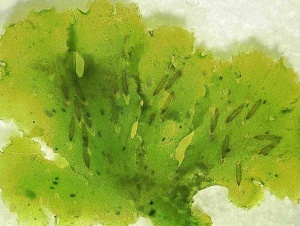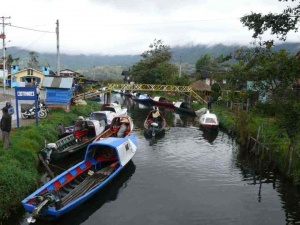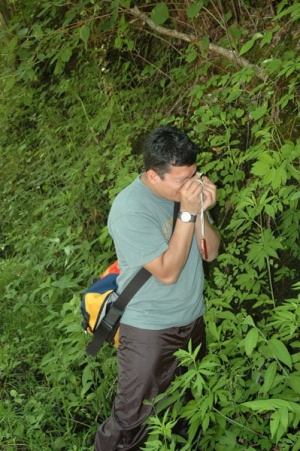Difference between revisions of "Juan Carlos Villarreal"
| Line 1: | Line 1: | ||
'''NEWS!!!''' | '''NEWS!!!''' | ||
| − | - In two weeks I will be heading to California and see some native hornworts for the first time. I have only seen these plants in the lab. | + | - In two weeks I will be heading to California and see some native hornworts for the first time. I have only seen these plants in the lab. Check out some Californian hornworts (and other bryophytes) spores in this website [http://www.csun.edu/~hcbio028/]. See also this note: [http://news.ucsc.edu/2007/08/1485.html] |
- Our recent paper on speciation and phylogeography of the lichen ''Peltigera'' in Macaronesia is available on-line (early view) [http://onlinelibrary.wiley.com/doi/10.1111/j.1365-2699.2010.02469.x/abstract] | - Our recent paper on speciation and phylogeography of the lichen ''Peltigera'' in Macaronesia is available on-line (early view) [http://onlinelibrary.wiley.com/doi/10.1111/j.1365-2699.2010.02469.x/abstract] | ||
Revision as of 19:13, 25 February 2011
NEWS!!!
- In two weeks I will be heading to California and see some native hornworts for the first time. I have only seen these plants in the lab. Check out some Californian hornworts (and other bryophytes) spores in this website [1]. See also this note: [2]
- Our recent paper on speciation and phylogeography of the lichen Peltigera in Macaronesia is available on-line (early view) [3]
- Our most recent paper summarizes hornwort diversity and brings up intriguing questions about this group of plants. The paper is free-access [4]
- A tribute to the outstanding Argentinian bryologist Gabriela G. Hässel de Menéndez was recently published [5]
- The most recent hornwort classification [6]
- The Geneva (G) Herbaria Catalogue has amazing information on hornwort types, with pictures of plants and notes made by specialists! totally worth taking a look at their website. Type "Anthoceros" and you'll get all types housed in Geneva! [7]
- Recent review of the book BRYOPHYTE BIOLOGY II: Check out this link [8]
Doctoral Student
Office: BioPharm 312
Voice: (860) 486-6306
Fax: (860) 486-6364
E-mail: juan.villarreal@uconn.edu, jcarlos.villarreal@gmail.com
Mailing address:
75 N. Eagleville Road, U-3043
Storrs, CT 06269
DISSERTATION RESEARCH
I am interested in the diversification and biogeographical distribution patterns of hornworts especially the Nothoceros alliance (including the Megaceros from the American Continent). My dissertation research is focusing on the major evolutionary events leading to the lack of sexual reproduction in the Southern Appalachian (SA) endemic and asexual hornwort Nothoceros aenigmaticus . The species is the only member of the genus in North America and there are no reported observations of sporophyte production. In the SA region male and female plants live ~ 30 miles apart and male plants produce depauperate antheridia (for unknown reasons sperm cells are unable to develop functional flagella). The proposed research has three main objectives:
1) Reconstruct the phylogenetic origin and timeframe of the loss of sexuality in N. aenigmaticus. 2) Assess the population genetic structure of clonal populations of N. aenigmaticus using microsatellites. 3) Estimate the molecular signature in the transition to asexuality using nuclear coding regions. 4) Transcriptomic and genomic data of N. aenigmaticus.
The first aspect of my research is unraveling the phylogenetic origin of N. aenigmaticus and its closest Neotropical relative using a multi-locus approach. I am also testing for any cryptic sexual recombination using microsatellites and exploring the genetic consequences of the lack of sex in the population dynamics of the SA populations. In addition I will be comparing patterns of genotypic diversity between SA populations and putative conspecific and sexually reproducing populations from tropical alpine regions. Given the potential extinction threat due to the Muller's ratchet effect (accumulation of deleterious mutations), this study will have conservation and evolutionary implications. The haploid nature of Nothoceros aenigmaticus makes the hornwort more vulnerable to deleterious mutations since no other allele is present in the gametophyte. (more details soon).
Using next generation technology (454 Roche) I will be exploring genomic and transcriptomic data from the gametophyte of this species (more details soon).
RESEARCH GRANTS
This research has beeen funded by the the National Science Foundation (DDIG) [9]; Ronald Bamford Fund, EEB Department, UCONN; International Association of Bryologists; International Association of Plant Taxonomists; Aaron J. Sharp Fund (University of Tennessee); Southern Appalachian Botanical Society.
CURRENT INTERESTS
Systematics, anatomy, ultrastructure, molecular evolution and biogeography of hornworts (Anthocerotophyta), especially American taxa. Dating, population genetics, genomic evolution and genetic implications of the loss of sex in bryophytes.
Other interests are the evolution of carbon concentration mechanisms in the hornwort chloroplast, especially the ultrastructural and physiological implications of the presence of an algal-like pyrenoid. Chloroplast genomes in bryophytes and effect of level of RNA editing in hornworts. An increasing interest is the evolution of transcriptomes in hornworts.
EDUCATION and COURSES
University of Connecticut, Ecology and Evolutionary Biology, USA. Spring 2006- Doctorate degree
Workshop on Molecular Evolution, Woods Hole, MA. July-August 2009 - http://workshop.molecularevolution.org/mbl/
Southern Illinois University, Department of Plant Biology, Carbondale, USA. Fall 2003- Dec. 2005- Master’s degree: Ultrastructure and evolution of hornworts with emphasis on symbiotic interactions with cyanobacteria and character evolution.
Universidad de Costa Rica & Organization for Tropical Studies (OTS), Costa Rica. Jan.-Feb. 2003 Graduate course in Tropical Ecology and Conservation
University of Panamá, Bachelor’s degree in Plant Biology with Major in Bryology. 1995-2003.
Humboldt Field Research Institute & University of Maine, USA. June 2001 Field undergraduate course on biosystematics of temperate bryophytes
PAPERS AND BOOK CHAPTERS (all peer-reviewed)
12. Sérusiaux, E., J.C. Villarreal A., T. Wheeler & B. Goffinet. (Accepted) Recent origin, active speciation and dispersal for the lichen genus Nephroma (Peltigerales) in Macaronesia. Journal of Biogeography
11. Villarreal, J.C.; B. Goffinet; R.J. Duff & D.C. Cargill &. 2010. Phaeomegaceros squamuliger subspecies hasselii (Dendrocerotaceae, Anthocerotophyta), a new taxon from the Southern Hemisphere. Nova Hedwigia 91 (3–4):000–000.
10. Villarreal, J.C., D.C. Cargill, L. Söderström, A. Hagborg & K.S. Renzaglia. 2010. Synthesis of hornwort biodiversity: Patterns, causes and future work. Phytotaxa 9:150-166. [10]
9. Villarreal, JC., B. Goffinet et al. 2010. Phylogenetic delineation of the genera Nothoceros and Megaceros (Dendrocerotaceae). The Bryologist 113 (1): 106-113.
8. Renzaglia, K.S., J.C. Villarreal & R.J. Duff. 2009 . New insights into morphology, anatomy and systematics of hornworts. In Bryophyte Biology II, B. Goffinet & J. Shaw (eds). (Book chapter) [11]
7. Villarreal, J.C., G. Hässel de Menéndez & N. Salazar Allen. 2007 Nothoceros superbus (Dendrocerotaceae), a new species of hornwort from the Neotropics. The Bryologist 110: 279-285. [12]
6. Duff, R.J., J.C. Villarreal, D.C. Cargill & K.S. Renzaglia. 2007. Progress and challenges toward developing a phylogeny and classification of the hornworts. The Bryologist, 110: 214-243.
5. Villarreal, J.C. & K.S. Renzaglia. 2006. Structure and development of Nostoc strands in Leiosporoceros dussii (Anthocerotophyta): a novel symbiosis in land plants. American Journal of Botany 93(5): 693-705. (Link to Cover [13]
4. Villarreal, J.C. & K.S. Renzaglia. 2006. Sporophyte structure in the neotropical hornwort Phaeomegaceros fimbriatus: implications for phylogeny, taxonomy and character evolution. International Journal of Plant Sciences 167: 413-427.
3. Dauphin, G.; T. Pócs; J. C. Villarreal & N. Salazar Allen. 2006. Nuevos Registros de Hepáticas y Anthocerotófitas para Panamá. Tropical Bryology 27: 73-85.
2. Cargill, D.C.; R.J. Duff, J.C. Villarreal & K.S. Renzaglia. 2005. Generic concepts in hornworts: historical review, contemporary insights and future directions. Australian Systematic Botany 18: 7-16.
1. Duff, R.J.; D.C. Cargill, J.C. Villarreal & K.S. Renzaglia. 2004. Phylogenetic relationships of the hornworts based on rbcL sequence data: novel relationships and new insights. Monographs in Systematic Botany from the Missouri Botanical Garden 98: 41-58. (Book chapter)
EDITED VOLUMES
J.C. Villarreal; W. Frey & D.C. Cargill. 2010. Bryophyte Biology, Phylogeography and Evolution in the Southern Hemisphere: In honour of Gabriela Hassel de Menendez. Nova Hedwigia 91(3-4): 1–250 pp. (A list of contributed and peer-reviewed papers on biogeography, niche modeling, cryo-microscopy, floristics and evolution of Southern Hemisphere bryophytes). [14]
PUBLICATIONS-BOOK REVIEWS (Non peer-reviewed)
- Villarreal, J.C. 2010. Before the Vascular plants. Book review of “Syllabus of Plant Families A. Engler’s Syllabus der Pflanzenfamilien. 3. Bryophytes and seedless vascular plants. 2009. Eds: Wolfgang Frey, Michael Stech & Eberhard Fischer. The Bryologist 113: 431–434.
- Villarreal, JC. 2009. Evolutionary implications of the lack of sexual reproduction in the Southern Appalachian endemic hornwort Megaceros aenigmaticus. Chinquapin 17 (1): 1. (A bulletin of the Southern Appalachian Botanical Society).
- Villarreal, JC. 2003. Efecto de la colonización de hepáticas epífilas sobre las hojas de Ischnosiphon sp.(Maranthaceae). Curso de Ecología Tropical y Conservación, OTS, Costa Rica. Pp. 311-313.
- Astudillo, E.; L. Lopes; M. Olazabal; D. Suarez; J.C. Villarreal; J. Forero & C. Cordero. 2003. Tamaño de la hoja y eficiencia de forrajeo en Atta chephalotes. Curso de Ecología Tropical y Conservación, OTS, Costa Rica. Pp. 293-296-313
- A.J. Sharp Award (American Bryological and Lichenological Society) Best student paper at the annual meeting of the American Bryological and Lichenological Society, Providence, RI. $500.
- Sullivant Award from the American Bryological and Lichenological Society for the best paper published in the Bryologist during the year 2007 for the paper " Progress and challenges toward developing a phylogeny and classification of the hornworts" . The Bryologist, 110: 214-243 by Duff, R.J., J.C. Villarreal, D.C. Cargill & K.S. Renzaglia.
- Michael J. Hogan (Current UCONN President) Summer Research Award-2009 (A nomination-based award given to 5 out of over 60 graduate nominees across UCONN). $5000
- Doctoral Dissertation Fellowship-UCONN- 2009.$2000
TEACHING EXPERIENCE (Teaching assistant for the following courses, mostly at UCONN otherwise specified)
- Evolution of Green plants (graduate and upper undergrad level class)
- Bryophyte and lichen biology (graduate and upper undergrad level class)
- Introduction to Botany
- Introduction to Biology
- Neotropical Environments (with McGill University, Panama Field Semester 2001)
FIELD EXPERIENCE
Panama, Costa Rica, Venezuela (Merida), Dominican Republic, Southern Appalachians, Mexico, Colombia (Pasto, Nariño)
AD-HOC REVIEWER
Journal of Experimental Botany; The Bryologist; Cryptogamie, Bryologie-Lichénologie, Fieldiana, Cambridge University Press; Nova Hedwigia; Tropical Bryology, Phytotaxa, Arctoa
INVITED TALKS
Early Land Plants Today/Encyclopedia of Life (World Meeting of Liverwort-Hornwort Taxonomy), The Field Museum, Chicago (2009);Congreso Colombiano de Botánica, Nariño, Colombia (2009); Department of Botany, The Field Museum, Chicago (2008); Department of Biology, University of New Mexico (2007); Congreso Latinoamericano de Botánica, Dominican Republic (2006); Department of Biology, University of Panamá (2006); World Congress of Bryology, Venezuela (2004).
LINKS
http://www.early-land-plants-today.org
http://hydrodictyon.eeb.uconn.edu/people/goffinet/Classificationhornworts.html
http://briologia.blogspot.com/






